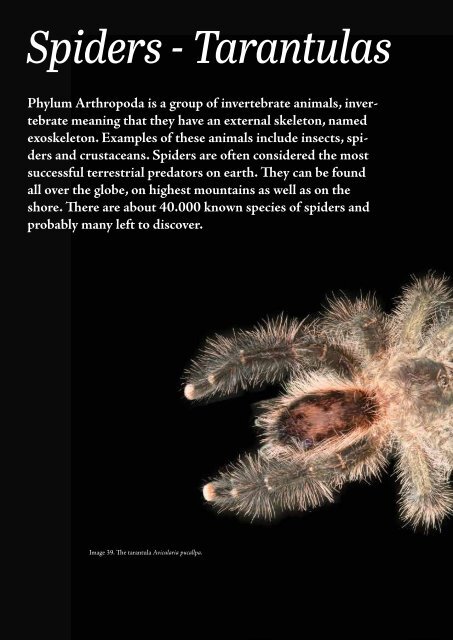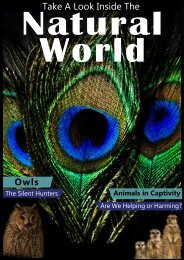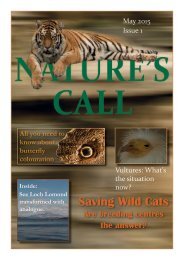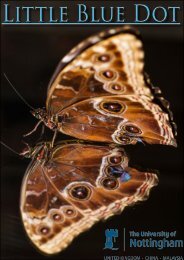NATURA
Create successful ePaper yourself
Turn your PDF publications into a flip-book with our unique Google optimized e-Paper software.
Spiders - Tarantulas<br />
Phylum Arthropoda is a group of invertebrate animals, invertebrate<br />
meaning that they have an external skeleton, named<br />
exoskeleton. Examples of these animals include insects, spiders<br />
and crustaceans. Spiders are often considered the most<br />
successful terrestrial predators on earth. They can be found<br />
all over the globe, on highest mountains as well as on the<br />
shore. There are about 40.000 known species of spiders and<br />
probably many left to discover.<br />
Our focus is on the family Theraphosidae, better known<br />
as tarantulas. They can be found from the southern and<br />
western parts of the United States, in Central America,<br />
and throughout South America. Other species occur<br />
in different areas throughout Africa, much of Asia, and<br />
all of Australia. In Europe, some species can be found<br />
in Spain, Portugal, Turkey, Italy, and Cyprus. They are<br />
found in a wide range of habitats; terrestrially in deserts,<br />
in large open areas of grassland, and in scrub forests,<br />
terrestrially and arboreally and in rain or moist forests<br />
as well. No species has been found as truly aquatic or<br />
marine, even though some choose to live near water.<br />
Tarantulas have in the recent years become popular as<br />
pets, so now they can be found in our homes as well. In<br />
this article our interest is on the behaviour and biology<br />
of tarantulas, and how to keep a tarantula as a pet.<br />
As mentioned earlier, the tarantulas have external skeleton.<br />
The exoskeleton defines the shape of the animal,<br />
is an attach point for the muscles, prevents evaporation<br />
and gives protection. When growing, they need<br />
to expand their former skeleton and make a new one<br />
bigger. This is a complex process called molting. Young<br />
tarantulas may do this several times a year, while fully<br />
grown individuals will only molt once a year or even<br />
less frequently. If a tarantula happens to loose a limb or<br />
urticating hairs (bristles), it may go through molting.<br />
An important thing when keeping tarantulas as pets<br />
is not to handle them while and right after molting,<br />
even not feed them for a few days because they can be<br />
harmed by their prey. Just make sure they have enough<br />
water. Another thing is that having an exoskeleton<br />
makes them fragile, and if dropped on the floor they can<br />
be crushed, possibly to death.<br />
Image 39. The tarantula Avicularia pucallpa.<br />
A spiders body is divided into two parts. The forward<br />
part, the prosoma, has the eyes, mouth fangs, stomach,<br />
brain and the poison glands. The legs are also connected<br />
to this part. The rear part is the opisthosoma, on its<br />
back end are the spinnerets, the silk producing glands.<br />
Between the prosoma and the opisthosoma there is a<br />
narrow part called the pedicel. Tarantulas have eight<br />
pairs of appendages on their bodies. The first one is<br />
chelicerae serving a different purpose in different species.<br />
It is located just below the eyes, directly forward<br />
the mouth.














